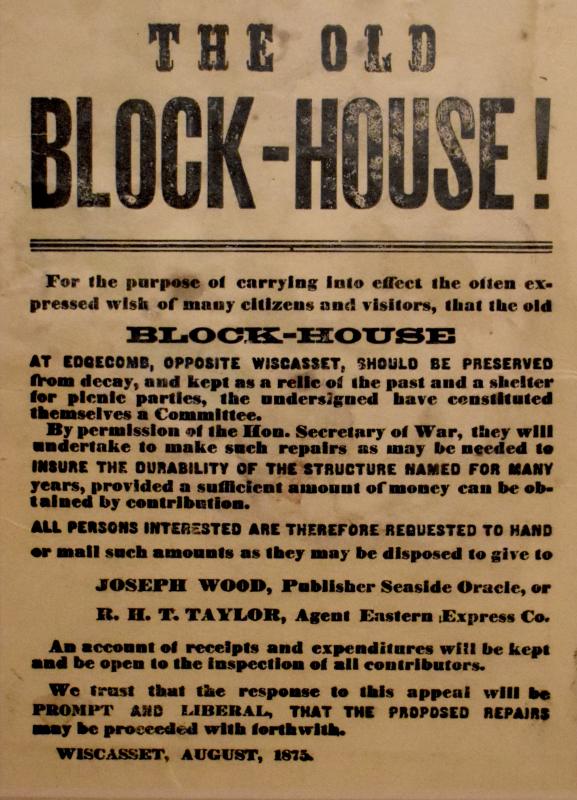Once upon a time in Edgecomb
The town of Edgecomb, “in the southern part of Lincoln County, is situated upon the peninsula formed by the Sheepscot and Damariscotta Rivers, having Newcastle on the north and Boothbay upon the south. At the northwestern part, it connects with Wiscasset by a bridge seven eighths of a mile in length across the Sheepscot River. West of the southern part of Edgecomb is the town of Westport... The surface of the town is moderately irregular (with many hills and valleys). Granite is the principal rock.”
That’s George J. Varney’s description of Edgecomb appearing in “A Gazetteer of the State of Maine” published in 1886. And it pretty much describes the town today, except for the bridge. The Davey Bridge which opened to traffic in 1983 spans 2,700 feet, about half the length of the original bridge. No, the river didn’t get narrower. What happened was when the state replaced the former timber pile bridge they built a long causeway on the Wiscasset end, filling in the first 13 spans to where the old toll keeper’s station was located.
Edgecomb is best known for Fort Edgecomb, the historic blockhouse built in 1808 and 1809. Now a popular state park, Fort Edgecomb overlooks a roiling river channel separating it from Westport Island called “Decker’s Narrows.” There’s also the celebrated Marie Antoinette House (privately owned) and the forested Schmid Land Preserve open to the public year-round.
Returning to Varney’s gazetteer, he incorrectly states the highest point in Edgecomb as Mount Hunger which rises almost unnoticeably 280 feet off Old County Road. Nearby, Mount Edgecombe is actually the town’s highest peak at about 320 feet. The lofty hill is named for Lord Edgecumbe, who by the way spelled his surname with a “u” and an “o.” We’ll get back to him in a moment. Mount Edgecombe is also known as “Bill John Williams Hill,” an early settler. If you’re inclined to hike to its summit, you can do so from the River Link Trail off McKay Road.
Not far from the trail head, you’ll cross a wooden footbridge where you’ll notice the path begins to go upwards. On your right, you’ll see a fairly high rocky knoll. In the 1700s, this area was called the “King’s Woods” because during the time of King George III, the towering northern pines that grew here were marked with a broad arrow to be cut and used as masts for the Royal Navy. It’s been said, after the high hill had been clearcut you could see the ocean from its summit. Not today. The trees have all grown up again to block the view.
Varney mentions Crystal Pond, near the center of the town (where the present town hall is). There is a body of fresh water of about 100 acres. This is an earlier name for what’s now called “Lilly Pond.” In the 1800s, a grist mill was here, where a water-powered millstone was used to grind grain into flour. Other early industries in Edgecomb include brickmaking on the Damariscotta River and ice harvesting at several locations including at a small pond off Shore Road.
There was also the Rosicrucian Springs near Haggett Hill where for a few years mineral water was bottled and sold as a health remedy. A granite quarry was on Cross Point Road where blocks were taken and used in the construction of the foundations for Lincoln County Courthouse and the Old Jail in Wiscasset. Edgecomb was also home to several open pit feldspar and mica mines near Mount Hunger. The pits dug mostly by pick and shovel can be found in Schmid Preserve. Feldspar, a white mineral, was the more valuable of the two ores as it was used as an ingredient to make fine china.
One of Edgecomb’s earliest English settlers was Samuel Trask who arrived around 1744. Trask, a seafaring man, arrived intent on giving farming a try. He bartered with the natives for a sizable piece of land at a place that came to be known as “The Heights,” a high point of land along the eastern shore of the Sheepscot River. Here he built himself a crude log home, took a wife and settled down to raise a family. The Heights is on Cross Point Road, and offers a fine view of Wiscasset harbor.
Samuel Trask had quite a colorful life and wasn’t shy about sharing tales of his remarkable adventures to any willing listeners. He claimed to have sailed with the infamous pirate Captain Kidd. Life was pretty good for Trask and the other early settlers until three men arrived from Boston to challenge their land claims. The story had a happy ending for Trask and his friends, thanks to an attorney who successfully defended their claims in court. Out of gratitude, the settlers named their community “Freetown.” The name stuck until 1774 when the general Court of Massachusetts renamed the community Edgecumbe (its original spelling) when it was incorporated as a town. The name honored Lord Edgecumbe, a friend to the American Colonies.
An early map of the community shows the town broken up into several areas: the Eddy, at Davis Island; the Mount Hunger region, Parson’s Point along Parson’s Creek; the Cross Point/Madockawando section and East Edgecomb where Merry Island and Poole’s Landing are. Got all that?
There were many notable residents who have called Edgecomb home. We’ll talk about them in a future column. More interesting facts about early Edgecomb can be found in an interesting two-volume history of town compiled by the late Katherine Chase Owen and published in 1986.
Event Date
Address
United States





























